Average Amount of Beddding Used in Beef Bedded Pack

A Composting Bedding System for Animals equally a Contribution to the Circular Economy
1
Livestock Inquiry, Wageningen University & Research, NL-6708 WD Wageningen, The Netherlands
two
Department of Agronomics, Food, Environs and Forestry, Academy of Florence, It-50145 Firenze, Italia
3
Institut für Tierzüchtung, Justus-Liebig Universität Gießen, DE-35390 Gießen, Federal republic of germany
four
Section of Beast Scientific discipline, Biotechnical Faculty, Academy of Ljubljana, SI-1230 Domžale, Slovenia
*
Author to whom correspondence should be addressed.
Bookish Editor: Antoni Sánchez
Received: 26 January 2022 / Revised: 18 February 2022 / Accepted: 25 February 2022 / Published: v March 2022
Abstract
Past-products from forestry, agriculture and nature areas are used in compost bedded-pack housing (CBP) systems for animals. In this communication, we discuss the awarding of a CBP organisation to animal farms and aspects related to the recycling and reuse of the materials in the context of a circular economy. This study is based on information from ongoing projects and literature. The following systems are discussed: (i) composting textile applied to a specialized creature housing system; (ii) adding a horticultural component to the brute farm by reusing the compost, and (iii) a cooperative mixed cattle and ingather farming system. The success of integrating a compost bedding component in the system depends largely on the skills of managing the composting procedure, the application of the material in the field, and the cost of acquiring the material. When materials are amply available, then a real contribution to the circular economic system can be made. Cooperation between farmers in the utilization of by-products is another route to a more circular economy. Moreover, the analyzed systems can be seen as a Greenhouse Gases (GHG) mitigation practise considering they store carbon in the soil and meliorate soil quality.
1. Introduction
There are many definitions of circular economy [1]. One definition is "an economic system of closed loops in which raw materials, components and products lose their value as little as possible, renewable energy sources are used, and system thinking is at the core". The three key Rs of sustainability are Reduce, Reuse and Recycle. Thus, the recycling and reuse of materials in agronomics contribute to a sustainable circular economic system. An example is the recycling of forest remnants from sawmills, straw from grain farming, grass cuttings from nature areas and roadsides, and discarded thatch from roofs. Such materials are used in animal housing as bedding. In this communication, we focus mainly on the bedding materials used in cattle barns, especially the innovative compost bedded-pack (CBP) barns where the materials are gradually mixed with animal excreta and regularly aerated. After some time, when the bedded-pack is (semi) composted, the compost is practical to the country and reused as a soil addition.
The majority of cows in the Western earth are housed in cubicle barns (free stalls; Figure 1) [two,3]. One cubicle per cow is ideal and a express corporeality of bedding material is used (see Figure 1). The CBP barn (Effigy 2) has a lying and movement surface area which, on average, is more than than twice that in a cubicle barn [4]. The bedding cloth layer increases over time equally fresh cloth is regularly added. The amount of bedding cloth used is known to be significantly higher than the quantity used in cubicle housing [4] and it gradually undergoes a composting procedure [5]. The CBP system for cattle was initially developed in Israel and the USA and spread, with some modification, to Europe in the terminal decade. Before long, it is increasing as a system in Brazil [half-dozen]. Information technology allows cows more than freedom of motion than conventional tie-stalls and cubicle barns [2,three,four]. The CBP is composed of a large bedded-pack, located in part of the barn and well-nigh times separated from the feed alley by a 0.5–1 m high physical wall. A successful composting process requires the input of oxygen, so the bedded-pack is mechanically cultivated once or twice daily (meet Effigy 3). Additional assistance to the composting procedure is provided, especially in holland, by supplementary aeration of the bedded area. For this, pipes are laid on the flooring under the bedded-pack (Figure three), which facilitates either the sucking or pushing of air through the pack [3].
Most studies describe the CPB barn as animal welfare friendly (less lameness, fewer hock and leg lesions, and more natural behavior than in mutual housing systems) [seven,eight], but opinions differ on the effects on animal health. A review written report [four] did not indicate real differences with respect to somatic prison cell count in milk from CBP compared to cubicle housing, but a report in progress using data from the FreeWalk project reported college jail cell counts in the CPB system [nine]. In general, a trend towards increased longevity of the cow herd is observed while estimates of the costs of housing differ. A multi-criteria analysis in Europe estimated higher costs for the CBP system mainly because of its larger surface area per brute [10]. In contrast, Usa researchers reported lower costs for the CBP organization [2]. Although housing structure requirements and costs differ among countries in that location is a general agreement that the CBP system has higher bedding costs than cubicle housing [ii,ten,11].
Compost bedding systems are likewise used in poultry husbandry [12]. Manure from poultry is drier than manure from cattle, which results in different management of the pack. Scratching of the pack by the birds serves as a natural means of aeration, in contrast with the mechanical cultivation used in CBP for cattle.
Compost production experiments in catering companies dealing with food waste [13], as well as agronomic characteristics of [fourteen] and gaseous emissions from the CBP materials [fifteen] were studied in view of circular processes. To our knowledge, no study has been reported linking CBP as a holistic system to the circular economic system. This advice study attempts to fill that gap. Aspects of three possible CBP systems (animate being based, animal plus horticulture, and mixed farming) are illustrated in the context of a circular economic system. Furthermore, farmer and consumer perceptions towards the compost bedding systems are summarized, and the key practices and difficulties to the successful application of the system are synthesized and discussed on the basis of existing projects and literature sources.
2. Materials Used
This communication synthesizes the results from previous and ongoing studies. Information technology is based on results from: (1) the FreeWalk project [16], with some additional analysis and observations. The FreeWalk project nerveless animal, climate, and nitrogen and phosphorus data from a group of study farms across vi European countries. A sample of 22 CBP instance farms and 22 reference cubicle farms with cattle were monitored during six visits in a two-year menstruation (2018–2019). The case and reference farms were paired based on similar characteristics and region. Farmer and consumer perceptions of the ii housing systems in the participating countries were assessed using surveys during 2018. In total, 78 farmers from half dozen European countries, all known to are working or acquainted with the two housing systems, and 3693 consumers from 8 European countries, participated in the respective surveys. (2) First outcomes of the Climate Care Cattle farming project [17], which monitors lx innovative farms in Europe in relation to carbon management and methane and ammonia emissions from the barns and fields. (3) Information about the management of bedding materials in poultry housing. (4) Literature sources (39), which supported describing the merit of compost bedding material systems for a circular economy.
3. Practices and Synthesis of Results
three.1. Circular Systems of Applying Bedding Fabric
Three such systems are described:
3.i.1. Application on a Dairy Farm
Wood fries and sawdust, among other materials, are used to develop the bedded-pack of, on average, 15 m2 per cow with a rather wide variation between countries [2,3,4]. The pack is mechanically aerated by use of a tractor with tillers. Additional aeration is provided by pipes installed to stimulate the composting procedure [3]. In spring, the exhausted pack fabric is transported and superficially spread on the country (Figure 4).
3.1.2. Application on a Poultry Farm
In Central Europe, corn spindle granules as left over from the maize harvest, amid other materials, are used every bit bedding. In a fattening period of 28–40 days, 1 kg bedding/yard2 volition finish upwards as 0.8 kg bedding/kg alive weight at a stocking density of 18–20 birds/chiliad2 [12]. Scratching of the pack by the birds serves as a natural means of aeration, while moisture is supplied via the ventilation system to assist the composting process, which can start as early as x days afterwards installation. Problems ascend if slab germination occurs due to coccidial disease or another reason, which ways the animals cannot scratc anymoreh. Brute welfare guidelines require the litter to be degradable. Mulching is a possibility to prevent or solve the formation of slabs (Figure five). Although some farms greatly appreciate hard, flexible litter, others observe that also much of it is eaten equally ballast by the laying hens [12]. The resulting compost from these farms can exist easily marketed.
3.1.3. Added Horticultural Activity Utilizing Composted Bedded Materials
During the grazing flavour when the cows are at pasture, the CBP barn tin can be used to grow horticultural products, such equally tomatoes and lettuce (Effigy vi). The building has a horticultural green-house type roof that allows sunlight to enter. A layer of about ten cm of sandy soil is spread over the bedded-pack, on which seedlings can be planted and the underlying compost supports plant growth [11]. This approach can lead to the auction of a mixture of agricultural products such as milk and vegetables from the one farm and the production arrangement is readily visible to visiting buyers of the produce. Notwithstanding, the system besides carries risks. Firstly, the addition of sand to the bedding and its later on removal is a tedious task that must be repeated each twelvemonth; secondly, the horticultural component of the organisation requires boosted temporary labor and skills [11].
3.ane.4. Cooperative Crop–Cattle Farm Exchange of Composting Materials and Manure
European agriculture has seen a continuous tendency of intensification and specialization with the result that mixed farming systems now embrace just fourteen% of the full agricultural expanse [xviii]. Intensification has advantages in economies of scale (efficiency of labor and equipment) only tin can also have drastic environmental consequences (on water and soil quality, on the atmosphere and biodiversity). Market volatility has increased over the years, and alongside climate change this threatens the resilience of specialized farms. For these reasons, "new" farming systems that prefer circular approaches are advocated with a view to further better efficiency, while reducing their climate and environmental impacts [18].
One such a system involves endmost the mineral loop past the commutation of materials and manure, and by the better use of manure (Figure 7). The mixed farming organisation fits this concept [19]. For instance, crop farming allows the composted materials to be incorporated into the soil. Collaboration on a local level will likewise play a crucial role in integrating different farming resources together with ingather and livestock farmers, as illustrated in Figure 7.
iii.2. Perceptions towards Bedded-Pack Barns and Compost
3.2.1. Farmers' Perceptions
Eighty-seven farmers from the six European countries involved in the FreeWalk project were selected on the footing of their experience with both CBP and cubicle housing systems and asked their opinions on these systems [xi]. This was done via questionnaire during group meetings, guided by the local researchers who explained the questions. A Likert scale of i to seven was used to compare the systems (i = very negative to seven = very positive).
The farmers from the diverse countries expressed quite similar opinions almost a set up of characteristics of the two housing systems (Table i). Those from all six countries considered the CBP system more sustainable and it offered more market opportunities than the common cubicle housing organization. In add-on, the composted bedding material was judged a meliorate soil improver. However, the toll of the bedding cloth was considered a highly significant negative aspect of the CBP system by all farmers [11]. In Europe, prices for fresh bedding materials range from around 100 euro to over 300 euro per ton [3].
3.2.ii. Consumers' Perceptions
An extensive consumer survey [20] was carried out in viii European countries to compare the iii nearly widely used cattle housing systems. The survey of random participants, which was carried out by a marketing agency, used photographs of the various housing systems to illustrate them to the respondees. A Likert scale of ane to 10 was used (1 = not worried at all/fully safe to 10 = very worried/non safety at all). Overall, the consumers were concerned over the safe of their food but felt that products grown using the compost from the CBP barns was safer (Table 2). Simply small differences existed between countries [20]; otherwise, all of the differences mentioned here were statistically significant (p < 0.05). Males were less concerned than females over food safe simply even so felt that nutrient from the CBP system was safer. Younger consumers were more than concerned most food safety than older consumers, and across all historic period groups, the youngest age group felt that food grown in the barn compost was less safe. Those in urban areas were more concerned over food safety than those in suburban areas and, compared with those in rural areas, felt that the food from the compost organization was less prophylactic [20]. Some responses in focus groups indicated concerns over antibiotic seepage, bacteria in the pack, and the hygiene of the pack [11].
3.three. Choices and Dilemmas
3.iii.1. Direction of the Bedded-Pack
Two key variables in managing the pack and creating a proper composting process are pack temperature and moisture content [ii]. A loftier temperature (45–65 °C) is considered necessary to create effective composting and material sanification [5,13,21]. The pack temperature (ten to 50 °C) and moisture content (55 to seventy%) at 20 cm deep of the 22 CBP included in projection FreeWalk are illustrated in Effigy 8 over 12 months [22]. A college temperature was associated with lower moisture content. Clearly, the optimal composting temperatures are not reached in practise. This is partly because the organization is however in development, only also because the need is not felt, such as in the summertime when the packs are mostly adept looking and dry out enough. In fact, under these conditions a semi-composting process takes place.
An over-moisture pack is detrimental to the composting process, and information technology also increases the dirtiness of the cows. Thus, managing the pack requires a item skill set [four,5,22]. In Europe, bedded-packs tend to be drier and warmer during the summer menses. However, higher temperatures most likely result in increased ammonia and methane emissions from the pack [15] and increased thermophilic leaner activity in the pack [23].
3.3.2. Bacterial Flora
Household litter composted in bedded-pack barns at higher temperatures was found to have high levels of thermophilic aerobic sporeformers (TAS) [24]. This may threaten the quality of sterilized milk products and, consequently, its utilize was prohibited in barns in holland. Certain strains of mastitis bacteria also like loftier temperatures [25], while other strains do not [7].
The moisture content of the bedding material, the relative humidity at 0.10 m and 1.xxx m above the surface, and the season of sampling, all significantly affected the level of TAS [23]. The relationship between moisture content and TAS is illustrated in Figure 9. A higher moisture content of the pack seems to be associated with less thermophilic activity, probably because of the lower temperatures and composting activity inside such a pack.
3.3.iii. Application in the Field
An important do good of composted bedding material is as a source of organic matter and nitrogen fertilizer for the soil [14,26] every bit illustrated in Figure ten. Although compost is known to meliorate the soil construction and bioactivity, the composting process is more complicated than more often than not appreciated. When the composting of bedding materials was experimentally faux in trials of three months duration, the stability of the organic affair did non betoken real evidence of composting [14]. Farther, some farmers have claimed an increased ash content (nonorganic matter) of grass samples harvested from compost treated swards [27], but this was not observed in the survey of the farmers described higher up (Tabular array one).
The boring release of nitrogen from the bedding materials has been reported by several authors [28,29] so grassland management and fertilizer appplication may demand to be adapted for the furnishings of compost bedding material as a fertilizer and soil construction improver.
3.3.4. Opportunities
The product from the successful composting of bedding materials mixed with excreta of animals is commercially valuable. Selling the compost in bags or loose as pellets provides the opportunity for additional income [29,30]. An case is the providing of organic bedding material past a CBP farmer in Slovenia to farmers engaged in the production of vegetable and flower seedlings.
Some farmers utilise the rut of the composting bedded-pack to warm upwards their subcontract office or visitors' room, or to prevent the animal drinking bowls from freezing. In another case, a German language farmer with both a CPB and cubicle barn reused virtually 75% of the CBP compost every bit bedding textile in the cubicle stalls with the balance used every bit fertilizer. It was estimated that this reduced the full bedding material costs past 80%. Later, the bedding material from the cubicles was used in the farm biogas plant to produce energy. These are examples of circularity within or betwixt farm businesses.
The relatively high cost of the bedding materials is a negative factor merely new materials such as Posidonia oceanica and miscanthus [31], and grass harvested in nature areas and on roadsides [32] should be less expensive.
Within the European Light-green Bargain Package [33] there are opportunities to increase carbon storage in soil to combat climate change. In the CBP system, carbon enters the farm via industry or agricultural by-products and is mixed with animal manure. This is then applied to the soil thereby sequestering carbon, which might otherwise be lost to the atmosphere. Carbon certificates are being considered every bit a tool for advancing the Dark-green Deal objectives. An innovative farmer in the Netherlands has already deployed a novel climate mitigation do on his farm. The air from manure storage, rich in ammonia and marsh gas, is pushed through tubes to a special drainage organization 60 cm underground from where information technology diffuses into the soil. The ammonia and methane are thought to be fixed by soil leaner, although this is non notwithstanding proven.
4. Discussion
The EU New Deal [33], and the Horizon Europe Research Program 2021–2027 [34], together with similar worldwide programs have, as top priorities, the achievement of carbon neutrality. The recycling and reuse of organic materials, including the use of organic bedding materials in CBP systems, can assistance to increment carbon storage in the soil. This contributes to mitigating global warming, improves soil construction and bioactivity, and enhances biodiversity. It is enhancing a circular economy.
While in Israel and Brazil there is widespread utilize of CBP systems, the number of such systems in all other countries remains limited [2,iii]. Much more mutual are the conventional 'deep straw' barns (yards) [two]. In these barns, the lying area consists of straw, which is stapled over time, but composting is not a systematic part of the arrangement and the surface per cow is less than in CBP. Deep straw barns are most widely used for fattening cattle and suckler cows. The relatively dry manure of these animals helps to maintain a rather dry pack. The pack tends to grow in volume during the season, while in CBP, composting degrades the material to smaller particles, which makes the pack more compact [21].
Although the CBP housing arrangement is nonetheless in development [two,3], both farmer and consumer surveys revealed positive impressions of its sustainability compared to cubicle or tie-stall barns [11,twenty]. The CBP system was also preferred on food safety criteria [xx]. Alongside these positive impressions, yet, are some concerns on the possible chance of bacteria and antibiotic transfer from the compost bedding material to the growing vegetables and horticultural products from compost treated soil [11].
The high fabric costs of the wood by-products and straw due to competition from bio-gas and other industries adversely affects the economic viability of the system. Accordingly, exploration of cheaper by-products and waste material products volition be of increasing involvement [11,xiv,31].
The operation of a successful bedded-pack organization requires particular direction skills. The composting procedure is affected by the temperature and wet content of the bedding, as well as the ambient temperature and humidity [four]. In temperate climates, maintaining adequate conditions and a proper composting process in the bedded-pack to achieve a stable humus-like finish-product, especially during the winter, tin can exist a astringent claiming [v,14,22].
While the composting process is enhanced by college temperatures, such temperatures also facilitate the growth of thermophilic leaner [23,24]. Bacteria such as (X)TAS are disliked by dairy processing companies in some countries considering of their possible furnishings on sterilized dairy products [24]. To date, research with CBP systems did not find any detectable (Ten)TAS in cows' milk even though detectable levels were found in the bedded-pack [35]. In addition, several strains of mastitis-causing leaner thrive in similar conditions to that of composting bacteria and microbes [7,24,25]. This suggests that the microbiology of the bedded-pack aerobic and anaerobic processes and the possible transfer of bacteria to the fauna and animal products may be complex and requires more fundamental research. Maintaining optimal animal hygienic procedures is likely to exist important [25].
Combining all of the new insights gained concerning the management of the bedded-pack leads to the conclusion that the moisture and dry out thing content may be the best indicator for the quality of the pack [22]. A dry pack (above 40% dry out-matter) has, indeed, several advantages such as a better composting procedure and cleaner cows [25], affecting the quality of the end-products. However, the risk of TAS [23,24] and item mastitis bacteria presence [25] increase with the combination of higher dry matter content and college temperatures of the pack. The composting procedure and take a chance of TAS presence is expected to deadening down when the pack reaches to a higher place approximately 65% dry affair, but more than noesis is needed to typify the ongoing processes in this dry matter range.
In addition, new insights into ammonia and carbon dioxide emissions from composting bedded-packs would be especially beneficial in evaluating these systems. 1 report indicated that the critical pack Carbon:Nitrogen (C:North) ratio at which volatile N loss from the barn was zero, was 35 in line with critical ratios constitute in other studies [36]. The authors ended that controlled thermophilic composting of a woodchip bedded-pack, at a relatively high C:Due north ratio, has the potential to minimize volatile N loss from the CBP barns. Some other written report [37] showed ammonia emission to be reduced by 32% but marsh gas emission was increased by 34% compared to a reference cubicle housing arrangement with slurry.
Organic bedding materials enriched with nitrogen and phosphorus from manure and urine is a proficient soil improver [26] comparable with one-time fashioned manure from tie-stall and deep straw barns. The CBP system aims to degrade the materials in the compost to a product ideal for spreading on grassland swards or soil. Nonetheless, when the composting procedure is incomplete, its application to grassland may consequence in some big particles which take longer to dethrone. This is not a problem in soil awarding where the compost is incorporated into the soil at some depth, equally in arable farming.
A mixed animal-crop farming organisation can make a positive contribution to the circular economy [18,26]. Such a system can be operated either within a single subcontract business or by cooperation between specialised animal and arable or open field vegetable farms [19]. Its utilise in individual farms, or via cooperation between farms, may likewise reduce the import of animal protein feed from outside of the farm, thereby conserving resources and reducing fossil fuel use while contributing to replenished soil carbon reserves [xix,34].
Most studies cited in this communication are on-subcontract based studies. Aditionally, models scaling-up from subcontract to regional or international level [38], including Life Cycle Assay (LCA) studies [13,39], are recommanded to motion-picture show the whole cycle of by-products and materials. Such studies should preferably also compare composting to other processes, such equally using the materials for energy production and include the complete (international) ship and marketing concatenation [39].
5. Conclusions
The recycling and reuse of by-products in agriculture can contribute to a sustainable round economy. In this communication, we focused on the recycling of bedding materials from animal barns, especially the innovative CBP barns, and on cooperative crop-animal farm exchange of composting materials and manure. A holistic and synthesizing approach was used to evaluate the contribution of these systems to the round economy.
Both farmer and consumer surveys revealed positive impressions of CBP's sustainability compared to cubicle or tie-stall barns. Reuse of the compost from the CBP organisation is besides promising for horticultural production. All the same, managing the bedded-pack requires a particular skill set, and the loftier costs of wood by-products and straw can adversely affect the economic viability of the arrangement. Accordingly, an exploration of cheaper and suitable past-products and waste products is of crucial involvement.
Mixed animal-crop farming systems that foster the exchange and reuse of materials would brand a positive contribution to the circular economic system. The recycling and reuse of organic materials helps to increment carbon storage in soil. This contributes to mitigating global warming and improved soil construction and bioactivity. Greater insight into ammonia and carbon dioxide emissions would exist beneficial in evaluating these systems. Additionally, the scaling-up of models from subcontract to regional, national, or international level is recommended to obtain an overview of the complete cycle of by-products and materials.
Author Contributions
Conceptualization, A.Grand., P.G., Grand.K.; methodology, A.K.; software, A.M.; validation, A.G.; formal assay, A.K., P.G.; investigation, A.M., P.Thousand., 50.50., M.B., M.K.; resource, M.Yard., A.Yard.; information curation, A.K.; writing—original typhoon preparation, A.Thousand.; writing—review and editing, A.K., P.Yard., L.Fifty., 1000.B., M.M.; visualization, A.K., P.G., M.K.; supervision, A.1000.; project administration, M.M.; funding conquering, P.G., M.One thousand. All authors take read and agreed to the published version of the manuscript.
Funding
This research was funded by the European Union'southward Horizon 2020 Research and Innovation Plan under Grant Agreements No 696231 and No 696356 for research carried out within the ERA-NET SusAn projects "FreeWalk" and "CCCfarming".
Information Availability Argument
The own information presented in this study are available on request from the authors.
Acknowledgments
We wish to thank our FreeWalk partners Ulf Emanuelson and Isabel Blanco Penedo (Swedish University of Agricultural Sciences), Sven Koenig (Justus Liebig University Giessen, Germany), Jantine van Middelkoop (Wageningen Livestock Research, holland), Matteo Barbari (University of Firenze, Italian republic), Elfriede Offner-Schroeck and Andreas Zentner (Raumberg-Gumpenstein, Austria) and Megan Waldrop and Jutta Roosen (Technical University Munchen) for profitable in translating, distributing and/or collecting data in the partner countries, as well every bit the partners of the CCCfarming project for discussions contributing to the content of this communication. We are grateful to Gerry Keane, Leixlip Co. Kildare, for the editing piece of work on this article.
Conflicts of Involvement
The authors declare no conflict of interest.
References
- Kirchner, J.; Reike, D.; Hekkert, M. Conceptualizing the circular economy: An assay of 114 definitions. J. Resour. Conserv. Recycl. 2017, 127, 221–232. [Google Scholar] [CrossRef]
- Bewley, J.Yard.; Robertson, L.G.; Eckelkamp, East.A. A 100-Twelvemonth Review: Lactating dairy cattle housing direction. J. Dairy Sci. 2017, 100, 10418–10431. [Google Scholar] [CrossRef] [PubMed]
- Galama, P.; Ouweltjes, W.; Endres, Chiliad.; Sprecher, J.R.; Leso, L.; Kuipers, A.; Klopčič, M. Future of housing for dairy cattle: Symposium review. J. Dairy Sci. 2020, 103, 5759–5772. [Google Scholar] [CrossRef] [PubMed]
- Leso, Fifty.; Barbari, 1000.; Lopes, M.A.; Damasceno, F.A.; Galama, P.; Taraba, J.L.; Kuipers, A. Invited review: Compost bedded-pack barns for dairy cows. J. Dairy Sci. 2020, 103, 1072–1099. [Google Scholar] [CrossRef]
- Hernandez, A.J.; Halbach, T.R.; Widmer, S.; Weithe, A. Media Evaluation for Composted Bedded Pack Dairy Barns; Projection, Study no. 2005-078; Academy of Minnesota: Minneapolis, MN, USA, 2006. [Google Scholar] [CrossRef]
- Damesceno, F.A.; University of Lavras, Brazil. Personal communication, 2020.
- Eckelkamp, E.A.; Taraba, J.L.; Akers, 1000.A.; Harmon, R.J.; Bewley, J.M. Understanding compost bedded pack barns: Interactions amongst ecology factors, bedding characteristics, and udder health. Livest. Sci. 2016, 190, 35–42. [Google Scholar] [CrossRef]
- Blanco-Penedo, I.; Ouweltjes, W.; Ofner-Schröck, Due east.; Brügemann, Yard.; Emanuelson, U. Symposium review: Animal welfare in free-walk systems in Europe. J. Dairy Sci. 2020, 103, 5773–5782. [Google Scholar] [CrossRef]
- Emanuelson, U.; Brügemann, K.; Klopčič, M.; Leso, 50.; Ouweltjes, W.; Zentner, A.; Blanco-Penedo, I. Fauna health in compost-bedded pack and cubicle dairy barns in six European countries. Animals 2022, 12, 396. [Google Scholar] [CrossRef]
- Hovstad, 1000.A.; NIBIO, Norway. Multi-criteria-analysis. Personal communication, 2021. [Google Scholar]
- Klopčič, M.; Erjavec, K.; Waldrop, M.; Roosen, J.; Engel, P.; Galama, P.; Kuipers, A. Consumers' and farmers' perceptions in Europe regarding the utilize of composted bedding material from cattle. Sustainability 2021, 13, 5128. [Google Scholar] [CrossRef]
- Hiller, P. Einstreu in der Geflügelhaltung-Tipps und Anregungen für ein gutes Einstreumanagement. Landwirtschaftszimmer Niedersachsen. EIP-Agri-Projekt CarboFeet-Beimischung von Pflanzenkohle. 2018. Available online: https://world wide web.lwk-niedersachsen.de/lwk/news/29729_Einstreu_in_der_Gefl%C3%BCgelhaltung-_Tipps_und_Anregungen_f%C3%BCr_ein_gutes_Einstreumanagement (accessed on 14 Jan 2022).
- Stunženas, E.; Kliopova, I.; Kliaugaite, D.; Pranas Budrys, R. Industrial symbiosis for optimal bio-waste management and production of a college value-added product. Processes 2021, nine, 2228. [Google Scholar] [CrossRef]
- Llonch, L.; Gordo, C.; Lopez, M.; Castillejos, L.; Ferret, A.; Balanya, T. Agronomic characteristics of the compost-bedded pack made with forest biomass or sawdust. J. Processes 2021, 9, 546. [Google Scholar] [CrossRef]
- Sayara, T.; Sanchez, A. Gaseous emissions from the composting procedure: Decision-making parameters and strategies of mitigation. Processes 2021, 9, 1844. [Google Scholar] [CrossRef]
- EU ERA-Internet SUSAN Project FreeWalk. Available online: www.freewalk.european union (accessed on xiv Jan 2022).
- EU Articulation Call ERA-NET SUSAN/ERA-GAS/ICT-AGRI Project Climate Care Cattle Farming. Available online: www.CCCfarming.eu (accessed on 14 January 2022).
- EIP-Agri Focus Group Study on Mixed Farming Systems. 2017. Bachelor online: https://ec.europa.european union/eip/agriculture/sites/default/files/fg16_mixed_farming_final-report_2017_en.pdf (accessed on 14 January 2022).
- Animal Chore Force. Inquiry and Innovation towards a More Sustainable and Circular European Agriculture, Exploring Synergies betwixt the Livestock and Crop Sectors. Plants for the Hereafter Position Paper. 2019. Bachelor online: http://animaltaskforce.eu/Portals/0/ATF/Downloads/ATF_PlantETP_joint-paper_Sept2019.pdf (accessed on 14 Jan 2022).
- Waldrop, Yard.E.; Roosen, J.R. Consumer acceptance and willingness to pay for cow housing systems in eight European countries. Q Open 2021, 1, qoab001. [Google Scholar] [CrossRef]
- de Bertoldi, 1000.; Vallini, G.; Pera, A. The biology of composting: A review. Waste material Manag. Res. 1983, 1, 157–176. Available online: https://www.fazverde.com.br/wp-content/uploads/2020/12/The-biology-of-composting.pdf (accessed on 14 Jan 2022). [CrossRef]
- Leso, L.; Galama, P.; Blanco-Penedo, I.; Bruegemann, Thousand.; Zentner, A.; Klopčič, M.; Hovstad, K.A.; Barbari, Thou. Bedding management in compost-bedded pack and cubicle barns for dairy cows in Europe. In V: Book of Abstracts of the 72nd Annual Meeting of the European Federation of Animal Scientific discipline: Davos, Switzerland, September 2021; Wageningen Academic Publishers: Wageningen, The Netherlands, 2021; p. 407. [Google Scholar]
- Giambra, I.J.; Jahan, Y.; Yin, T.; Engel, P.; Weimann, C.; Bruegemann, G.; Koenig, S. Identification of thermophylic aerobic sporeformers in bedding material of compost-bedded dairy cows using microbial and molecular methods. Animals 2021, 11, 2890. [Google Scholar] [CrossRef]
- Driehuis, F.; Lucas-van den Bos, E.; Wells-Bennik, G.H.J. Risico's van microbiële contaminanten van strooisels: Compost, geschieden mest, paardenmest en vrijloopstallen; NIZO: Ede, Holland, 2012. [Google Scholar]
- Black, R.A.; Taraba, J.L.; Solar day, G.B.; Damasceno, F.A.; Newman, Chiliad.C.; Akers, K.A.; Wood, C.L.; McQuerry, K.J.; Bewley, J.Chiliad. The relationship betwixt compost bedded pack operation, management, and bacterial counts. J. Dairy Sci. 2014, 97, 2669–2679. [Google Scholar] [CrossRef]
- Middelkoop, J.C.; Van De Boer, C.H.; Galama, P.; Brügemann, Chiliad.; Leso, Fifty.; Blanco-Penedo, I.; Zentner, A.; Klopčič, M. Characteristics of organic manure from ʼFreewalkʼ housing, compared with slurry, and their appreciation by farmers. In Proceedings of the 28th General Meeting of the European Grassland Federation, Helsinki, Republic of finland, Oct 2020; Grassland Scientific discipline in Europe; Natural Resources Institute (Luke): Helsinki, Finland, 2020; Volume 25, pp. 686–688. [Google Scholar]
- Bakhuizen, G.; farmer from Abcoude, Kingdom of the netherlands; Wieringa, J.; Farmer from Doorwerth, The Netherlands. Personal communication, 2019.
- Alemi, H.; Kianmehr, G.H.; Borghaee, A.G. Effect of pellet processing of fertilization on tedious-release nitrogen in soil. Asian J. Found Sci. 2010, nine, 74–fourscore. [Google Scholar] [CrossRef]
- Pampuro, North.; Caffaro, F.; Cavalo, E. Reuse of brute manure: A case study on stakeholders' perceptions about pelleted compost in Northwestern Italy. Sustainability 2018, ten, 2028. [Google Scholar] [CrossRef]
- Eggerth, L.L.; Diaz, L.F.; Chang, M.T.F.; Iseppi, L. Chapter 12 Marketing of composts. Waste Manag. 2007, 8, 325–355. [Google Scholar]
- Ferraz, P.F.P.; Ferraz, Chiliad.A.; Leso, L.; Klopcic, 1000.; Rossi, G.; Barbari, Yard. Evaluation of the physical backdrop of bedding materials for dairy cattle using fuzzy clustering assay. Animals 2020, 10, 351. [Google Scholar] [CrossRef]
- Heijbroek., W.; Project Leader Waterschap Stichtse Rijnlanden, The Netherlands. Personal communication, 2021.
- Eu Green Bargain Package. 2019. Available online: https://www.switchtogreen.eu/the-eu-green-deal-promoting-a-green-notable-circular-economy/ (accessed on 14 January 2022).
- Horizon Europe. 2021. Bachelor online: https://ec.europa.eu/info/research-and-innovation/funding/funding-opportunities/funding-programmes-and-open-calls/horizon-europe_en (accessed on 14 January 2022).
- Bruegemann, K.; Justus Liebig University, Giessen, Germany; Galama, P.; Wageningen University & Enquiry, Wageningen, Holland. Personal communication, 2021.
- De Boer, H.C.; Wiersma, M. Thermophilic composting of the pack can reduce nitrogen loss from compost-bedded dairy barns. Biosyst. Eng. 2021, 210, 20–32. [Google Scholar] [CrossRef]
- van Dooren, H.J.C.; Hol, J.K.G.; Blanken, K.; Galama, P.J. Gasvormige Emissies Uit Vrijloopstallen Met Houtsnipperbodems; Report 1163; Wageningen Academy & Research: Wageningen, Holland, 2019. [Google Scholar]
- Yang, Z.; Muhayodin, F.; Larsen, O.C.; Miao, H.; Xue, B.; Rotter, V.Southward. A review of composting process models of organic solid waste matter with a focus on the fates of C, N, P and M. Processes 2021, nine, 473. [Google Scholar] [CrossRef]
- De Boer, I.J.One thousand.; Van Ittersum, M.1000. Circularity in Agricultural Production; Wageningen Academy & Research: Wageningen, Kingdom of the netherlands, 2018; Bachelor online: https://www.wur.nl/upload_mm/7/5/five/14119893-7258-45e6-b4d0-e514a8b6316a_Circularity-in-agricultural-production-20122018.pdf (accessed on 14 January 2022).
Figure 1. Cubicle barn for dairy cows.
Figure one. Cubicle befouled for dairy cows.
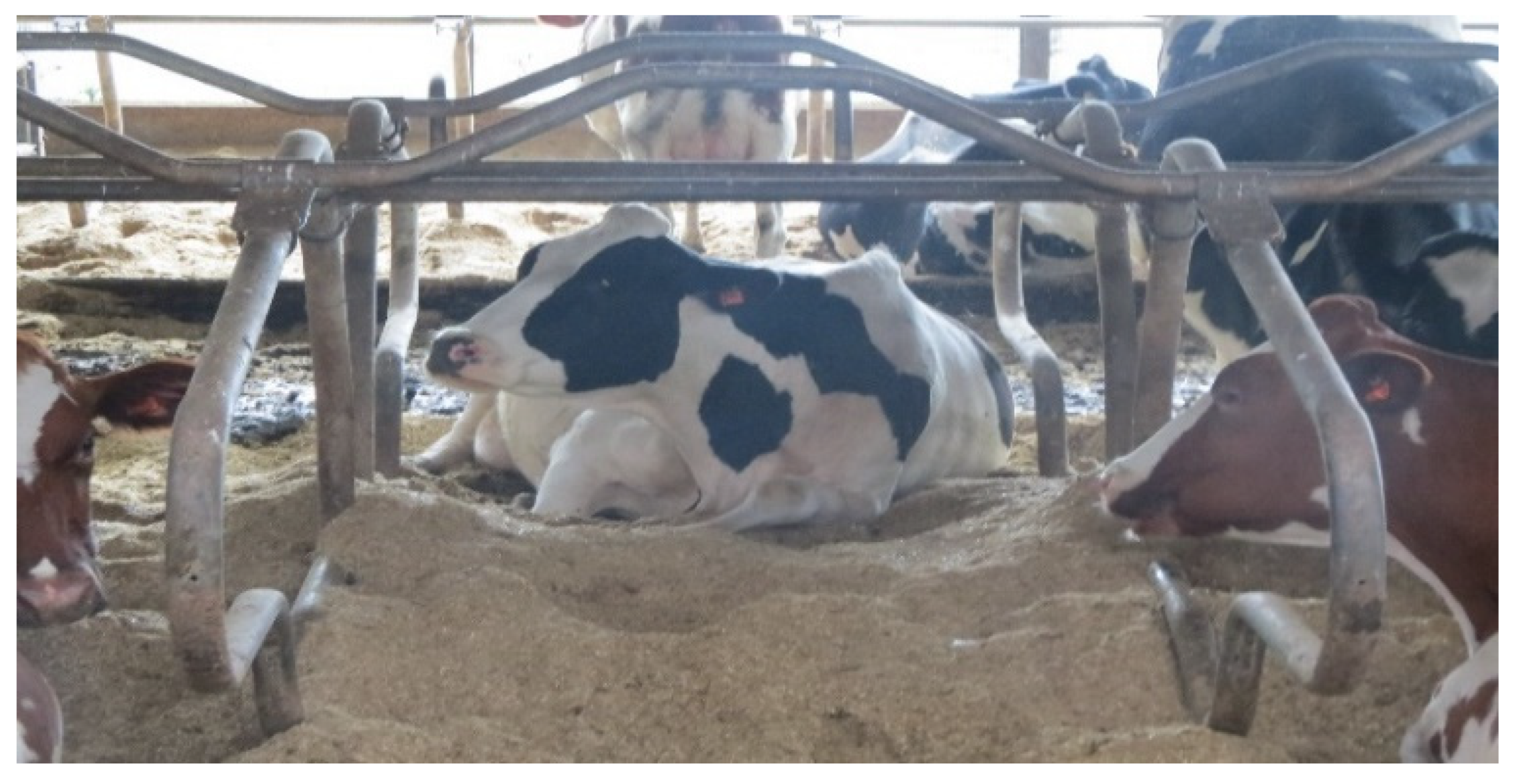
Figure 2. Compost bedded-pack (CBP) barn for dairy cows.
Figure two. Compost bedded-pack (CBP) barn for dairy cows.
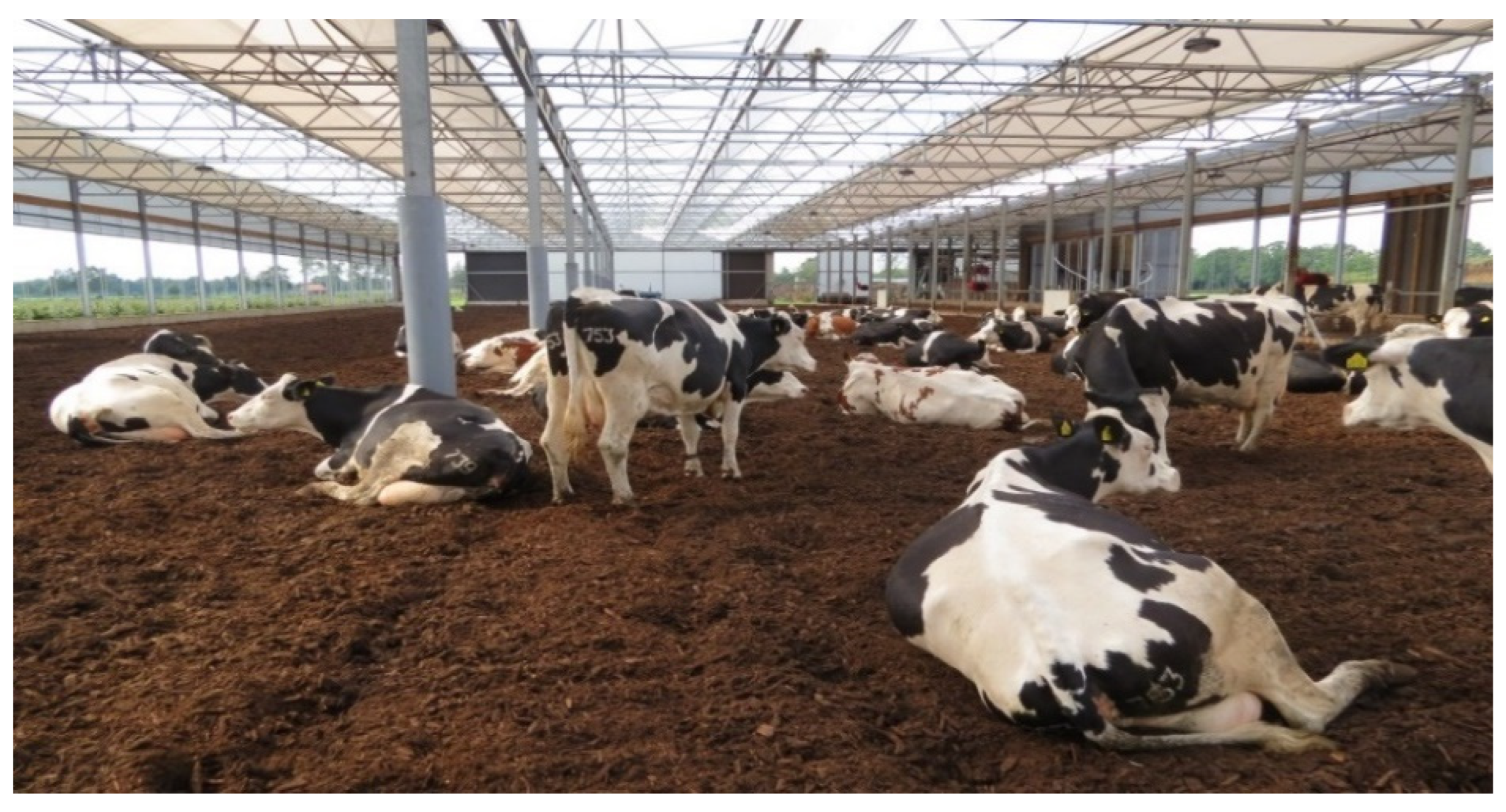
Effigy 3. Illustration of the stimulation of the composting process past mechanically aerating with oxygen into the pack (left) and the use of pipes in the physical floor for suckling or pushing air in the bedded-pack (right). Source: Authors.
Effigy 3. Illustration of the stimulation of the composting procedure by mechanically aerating with oxygen into the pack (left) and the use of pipes in the concrete floor for suckling or pushing air in the bedded-pack (correct). Source: Authors.

Figure 4. Dairy farm with compost bedded-pack and its application in the field. Source: Authors.
Figure 4. Dairy farm with compost bedded-pack and its application in the field. Source: Authors.
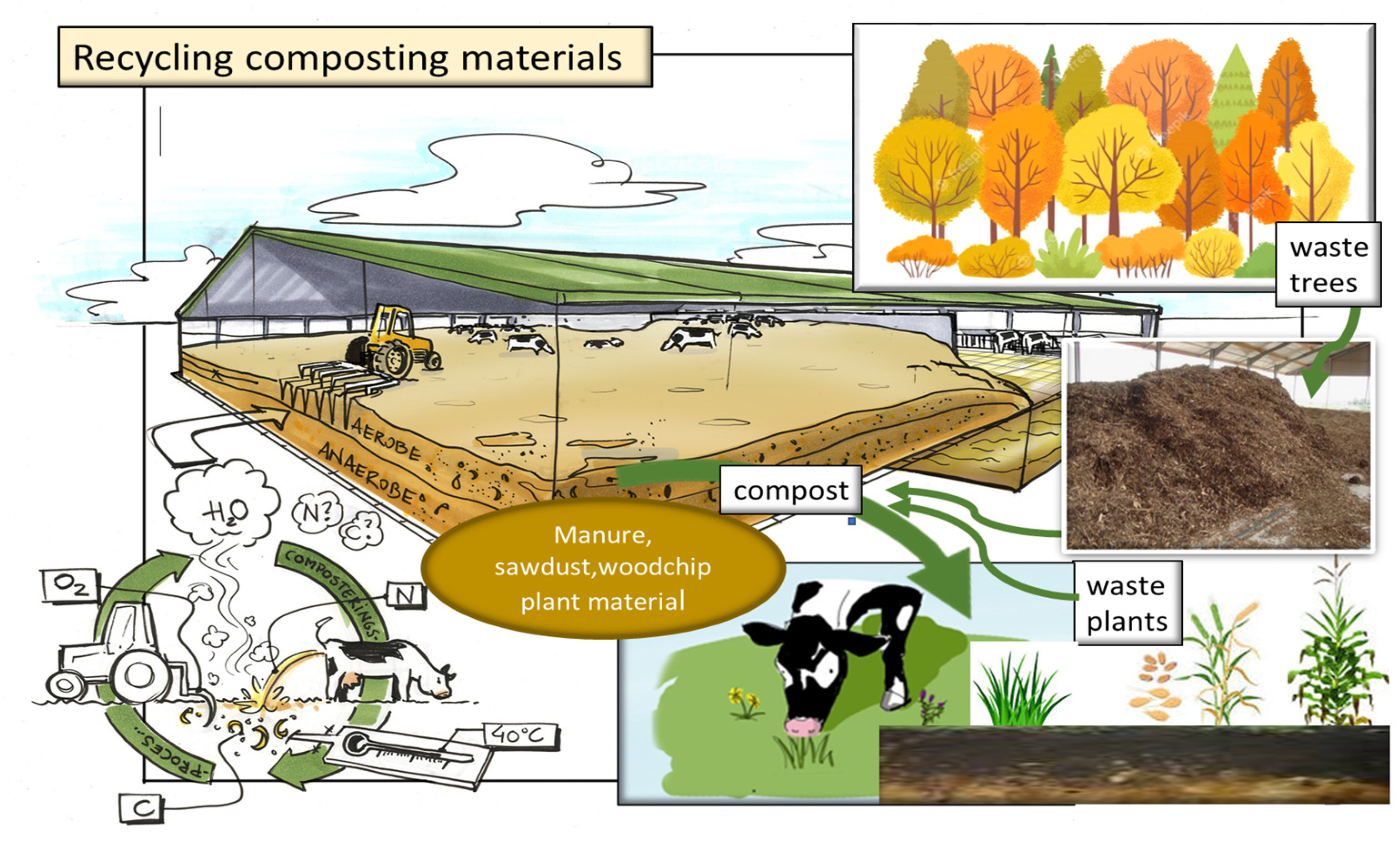
Figure five. Mulching of slabs in a broiler housing facility. Source: Hiller, P., 2018 [12].
Effigy 5. Mulching of slabs in a broiler housing facility. Source: Hiller, P., 2018 [12].
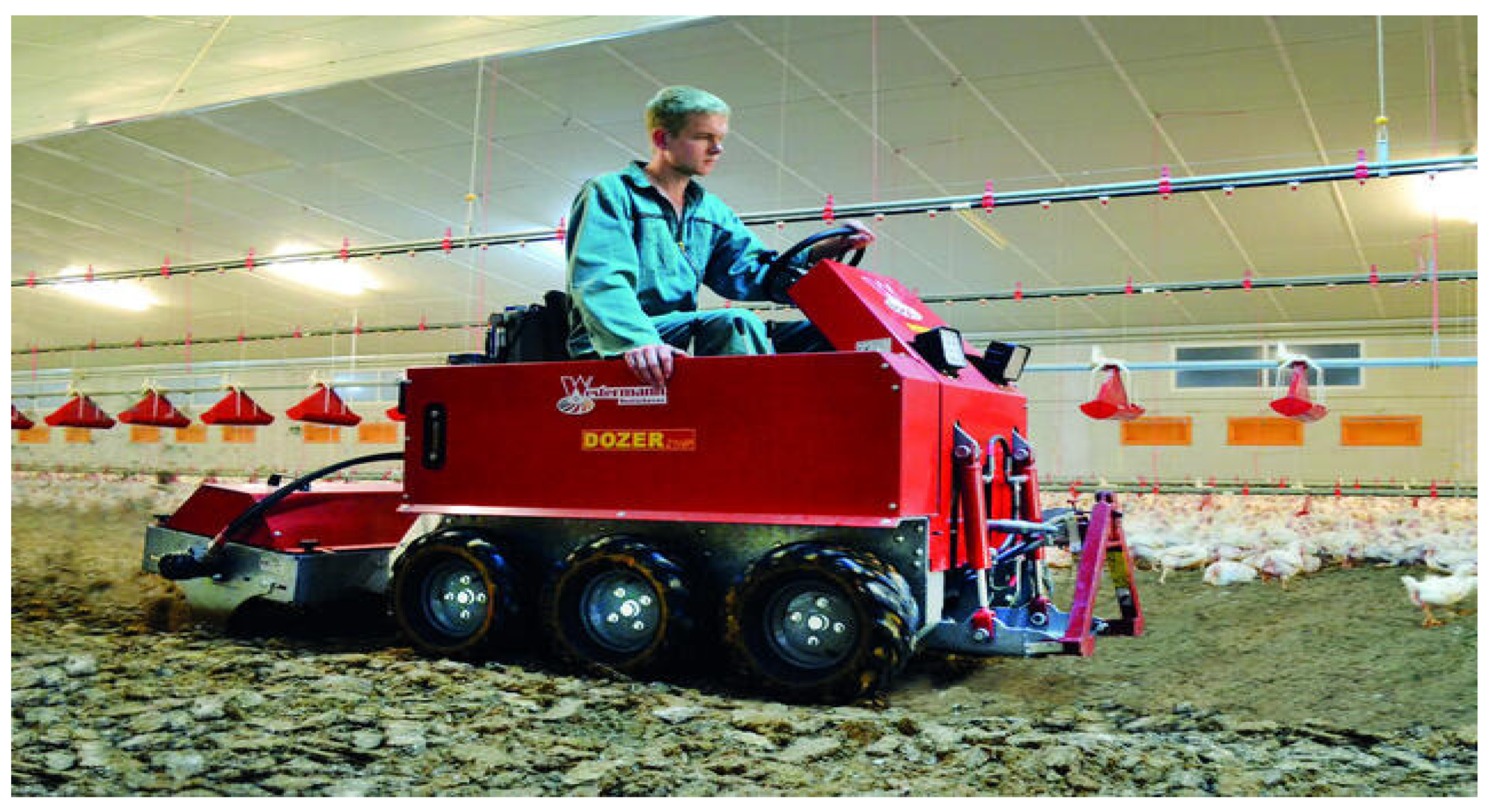
Figure 6. Utilizing a compost bedded-pack befouled for growing horticultural products. Source: Farm Veld & Beek, Doorwerth, the Netherlands.
Effigy six. Utilizing a compost bedded-pack befouled for growing horticultural products. Source: Subcontract Veld & Beek, Doorwerth, holland.
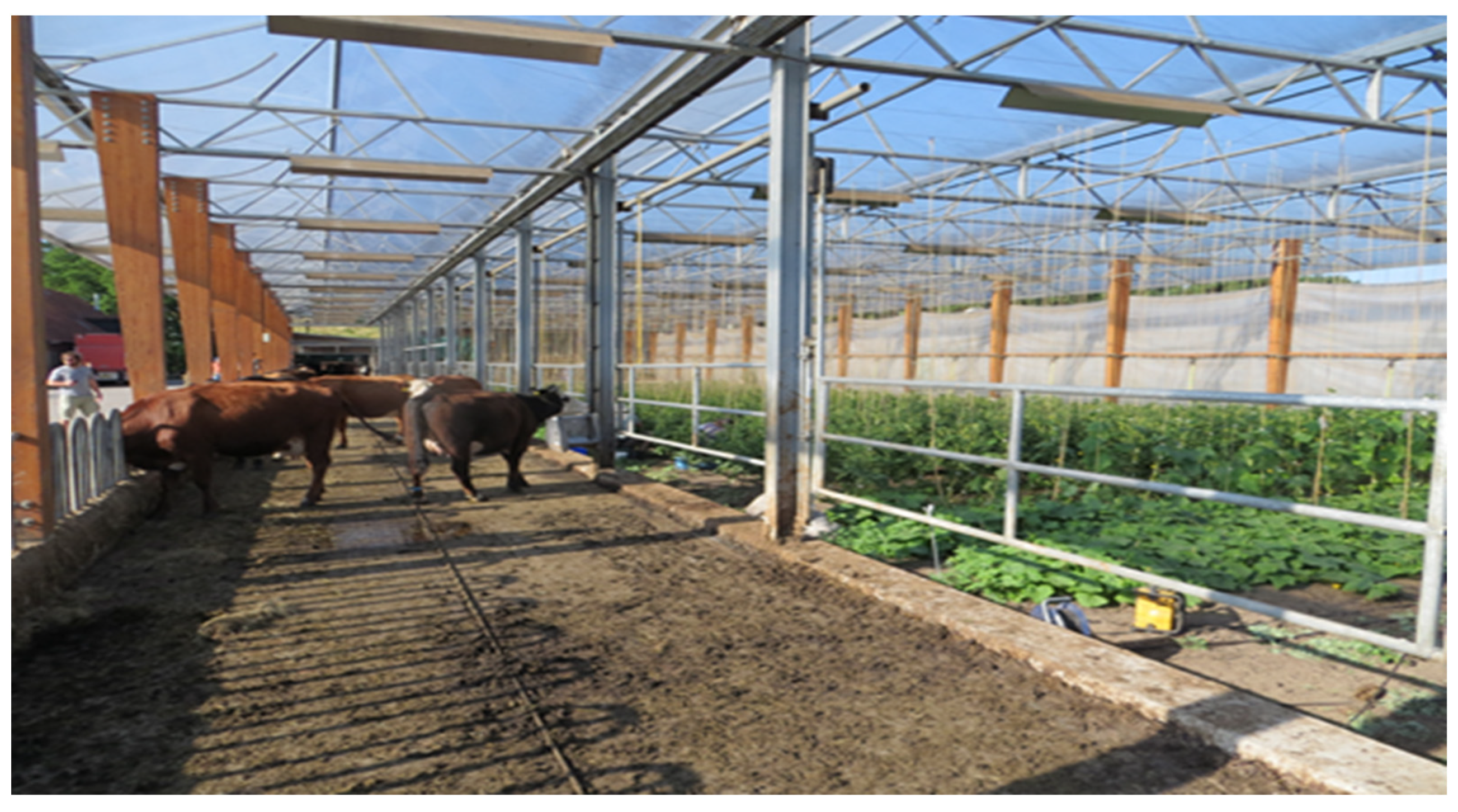
Figure 7. Mixed farming every bit a system realizing a circular economy. Source: Authors.
Figure seven. Mixed farming as a system realizing a circular economy. Source: Authors.
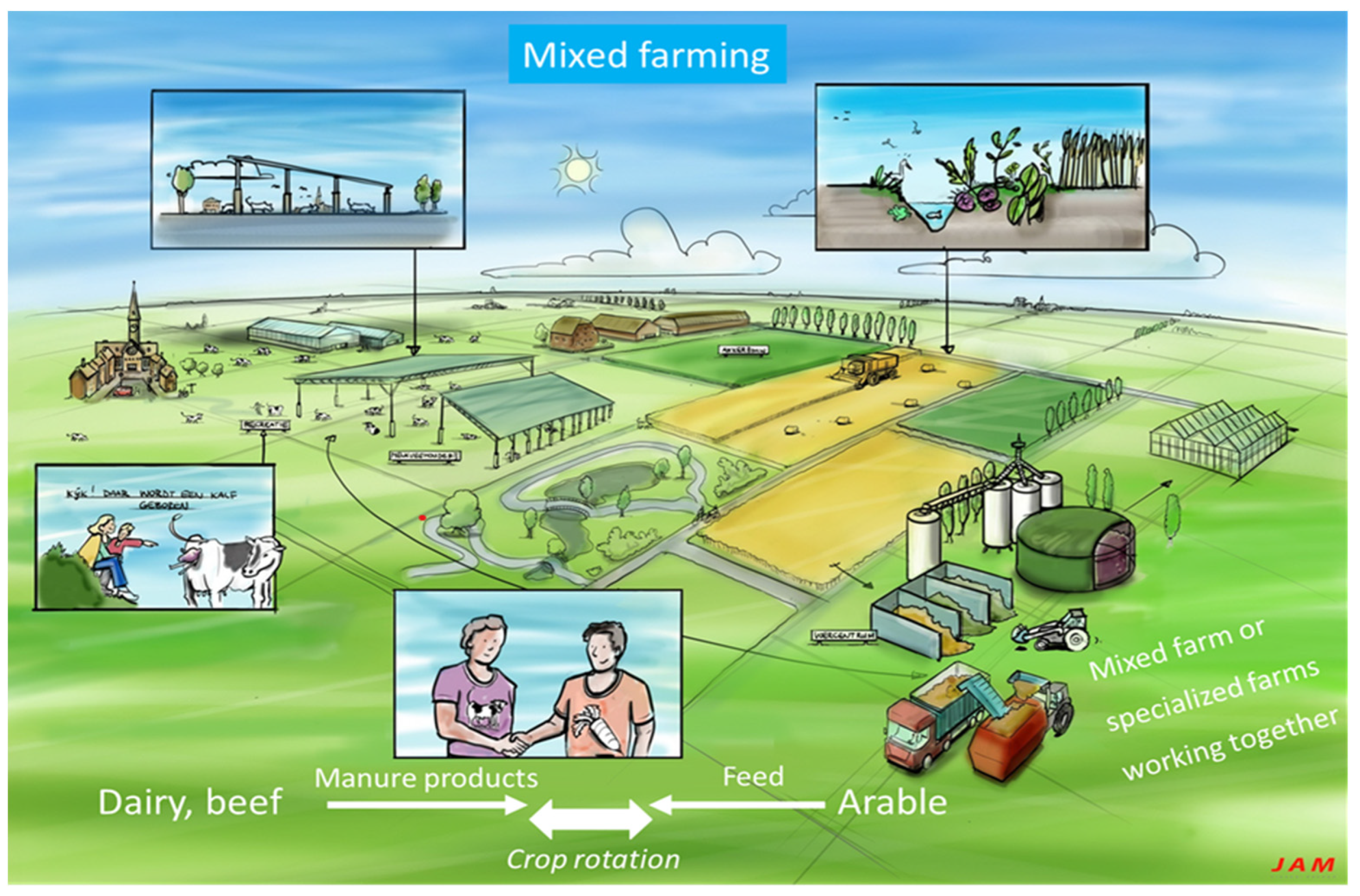
Figure 8. Development of the boilerplate and range in temperature (left) and the moisture content (correct) at twenty cm deep in 22 composting bedded-pack'due south over the twelvemonth. Source: Taken from Leso, L., 2021 [22].
Figure 8. Development of the average and range in temperature (left) and the wet content (correct) at 20 cm deep in 22 composting bedded-pack'southward over the year. Source: Taken from Leso, Fifty., 2021 [22].
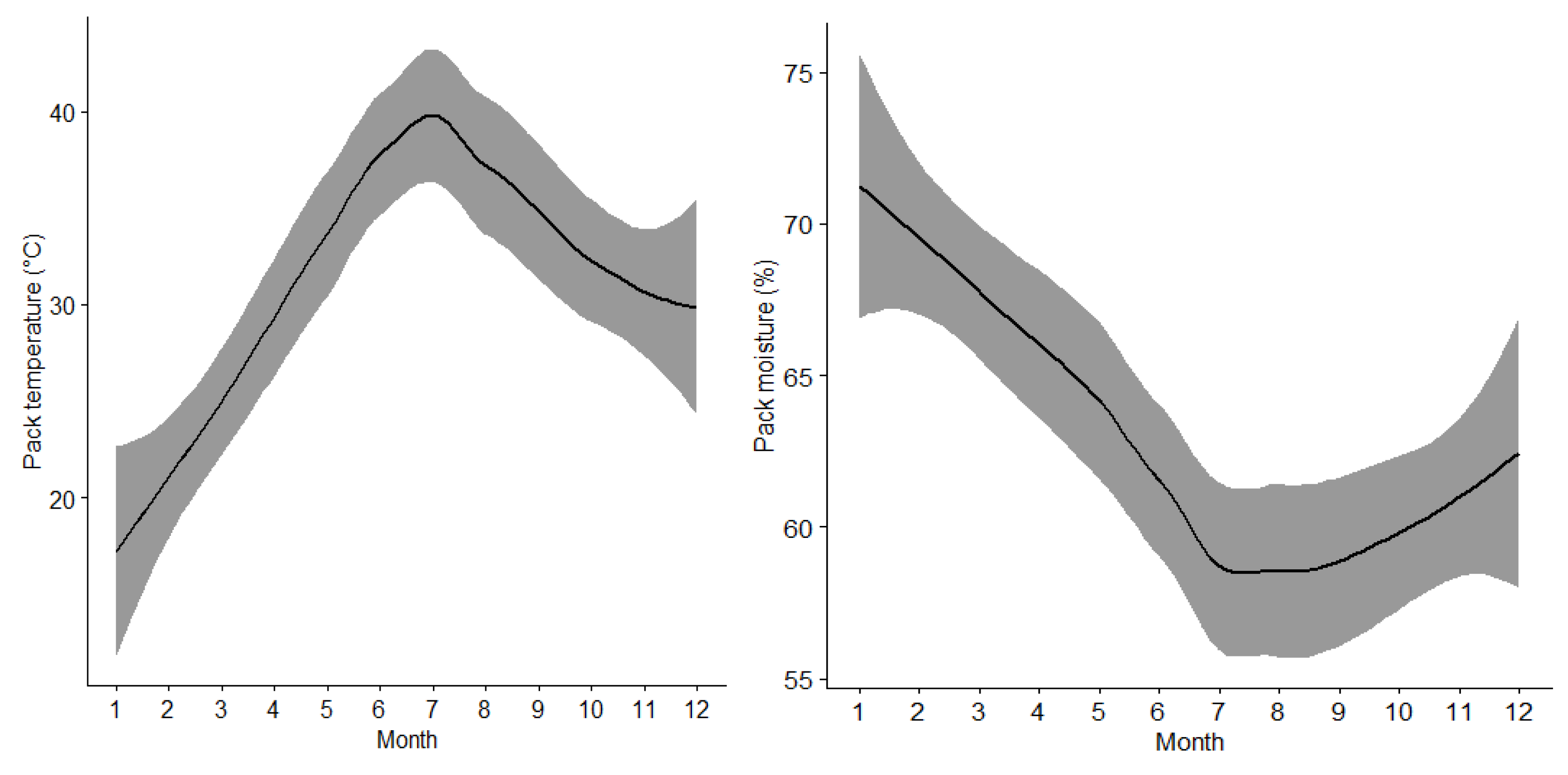
Figure ix. Human relationship betwixt thermophilic leaner and moisture content in composting bedding material; y = −0.08x + 8.62 (R2 = 0.34). Source: Taken from Giambra et al., 2021 [23].
Figure 9. Human relationship between thermophilic leaner and moisture content in composting bedding material; y = −0.08x + 8.62 (R2 = 0.34). Source: Taken from Giambra et al., 2021 [23].
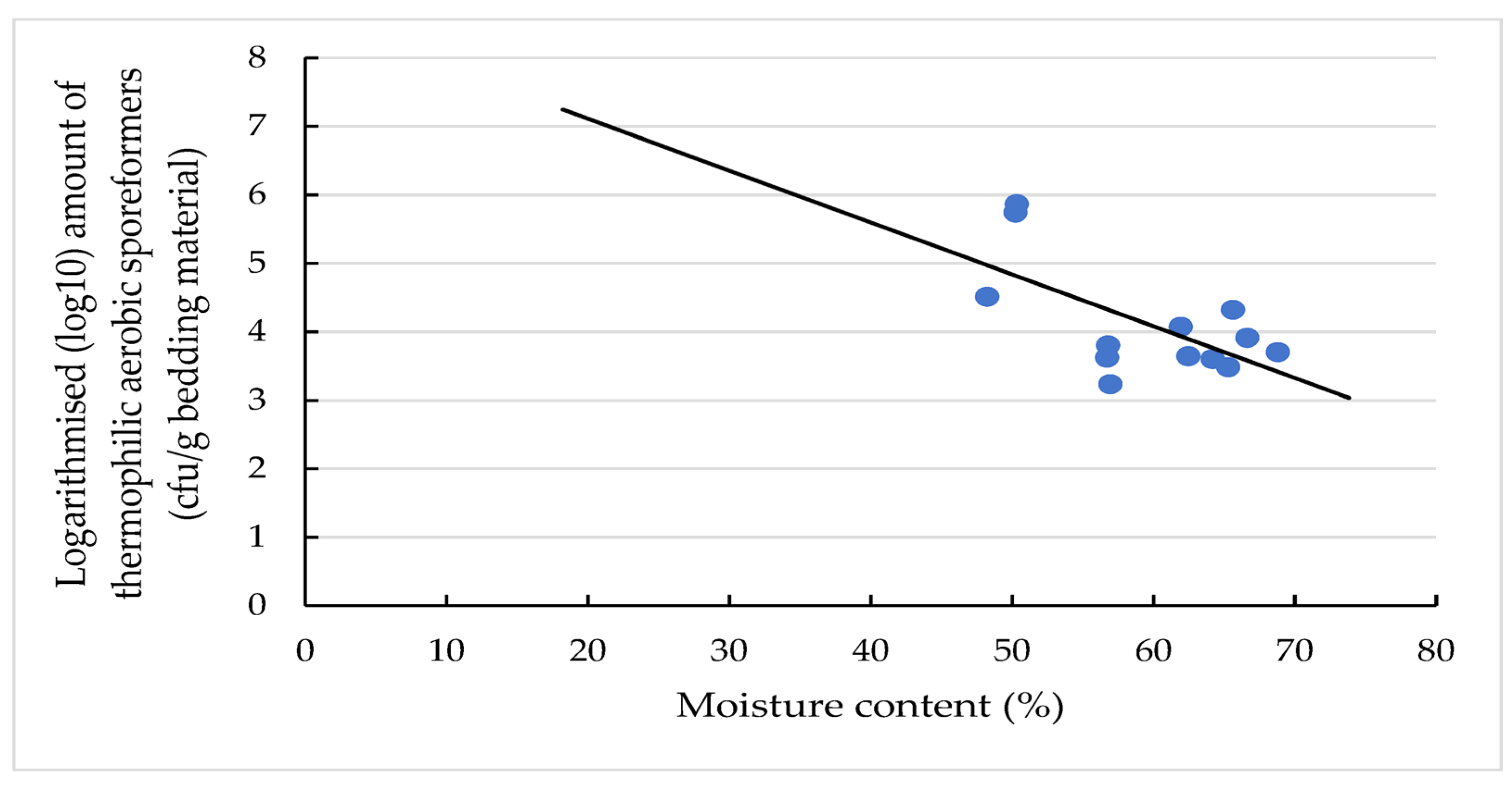
Effigy 10. Bedding material spread on grassland and arable land. Source: Authors.
Figure 10. Bedding textile spread on grassland and arable land. Source: Authors.
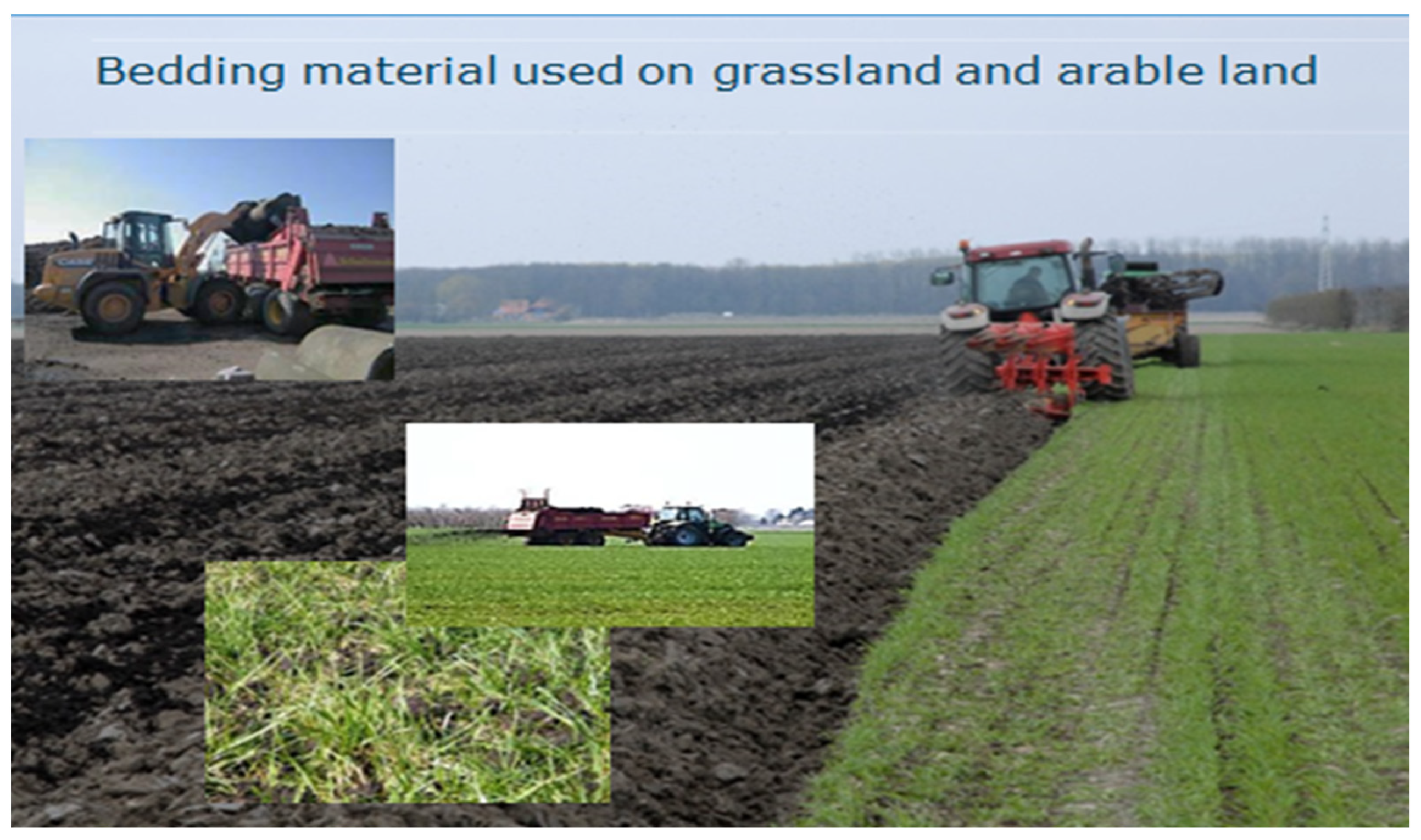
Table 1. Appreciation of composting bedding textile in CBP versus regular manure in cubicle housings (C) past farmers from these 2 farm housing systems in half dozen European countries (scores from 1 = very negative to seven = very positive) 1,2.
Table 1. Appreciation of composting bedding material in CBP versus regular manure in cubicle housings (C) by farmers from these two subcontract housing systems in six European countries (scores from one = very negative to 7 = very positive) ane,2.
| All 6 Countries Total | ||||
|---|---|---|---|---|
| CBP | C | CBP-C | Isle of mann-Whitney Test | |
| Cost aspect | ||||
| Cost of bedding material | three.58 | 5.53 | −ane.95 | 0.000 *** |
| Sustainability aspects | ||||
| Bedding material and slurry as soil improver | vi.xv | iii.61 | 2.54 | 0.000 *** |
| Bedding material and slurry as fertilizer | five.82 | 4.06 | 1.76 | 0.000 *** |
| Bacteria in bed and milk | 5.15 | 4.91 | 0.23 | |
| Smell | v.98 | four.53 | 1.45 | 0.000 *** |
| Marketing aspects | ||||
| Amend animate being life certificate | 6.05 | 3.52 | 2.54 | 0.000 *** |
| High quality dairy products | v.69 | four.06 | 1.63 | 0.000 *** |
| High quality manure products | 5.67 | 3.32 | 2.34 | 0.000 *** |
Table 2. Hateful scores and standard deviations for worry about (a) the safety of food consumed in general (1 = "non worried at all" to 10 = "very worried") and (b) safe of consuming food products using the compost from the compost bedded-pack housing organization (1 = "fully safe" to x = "not prophylactic at all") by country and in full ane,2.
Table 2. Mean scores and standard deviations for worry about (a) the prophylactic of food consumed in general (1 = "not worried at all" to ten = "very worried") and (b) prophylactic of consuming food products using the compost from the compost bedded-pack housing arrangement (1 = "fully safe" to 10 = "not safe at all") by state and in total 1,2.
| (a) Food Safety Worry in General | (b) Compost Nutrient Products Prophylactic | |||
|---|---|---|---|---|
| Variable | Mean | Std. Dev | Mean | Std. Dev. |
| Country | ||||
| Republic of austria | half-dozen.01 cd | 2.twenty | 3.02 bc | 1.85 |
| Germany | 6.15 c | 2.18 | iii.thirteen c | 1.86 |
| Italia | 7.62 a | 1.79 | 3.xv c | 1.90 |
| Netherlands | 5.65 d | 2.15 | 3.21 c | 1.66 |
| Norway | 5.65 d | two.67 | 2.sixty a | 1.97 |
| Slovakia | 6.94 b | 2.22 | 3.07 bc | two.00 |
| Slovenia | vii.88 a | 2.10 | 2.37 a | 2.24 |
| Sweden | v.77 cd | 2.43 | 2.77 ab | two.09 |
| Full | 6.49 | 2.36 | 2.94 | one.96 |
| Publisher'due south Note: MDPI stays neutral with regard to jurisdictional claims in published maps and institutional affiliations. |
© 2022 by the authors. Licensee MDPI, Basel, Switzerland. This commodity is an open admission article distributed under the terms and conditions of the Creative Commons Attribution (CC Past) license (https://creativecommons.org/licenses/by/4.0/).
Source: https://www.mdpi.com/2227-9717/10/3/518/htm
0 Response to "Average Amount of Beddding Used in Beef Bedded Pack"
Postar um comentário